Don’t dismiss Yamamoto no Hamburg because of its bright pastel decor and cute illustrations of smiling burger patties on the wall. This hambaagu — Japanese hamburger steak — joint serves some pretty intricate and creative dishes with great flavor.
All main dishes are some sort of variation of the hambaagu. Resembling more of a Salisbury steak, it is eaten on a plate alongside veggies and rice, and usually topped with some sort of sauce. No buns are included.
Yamamoto serves a fancier version than the simple, “comfort food” type found in the home kitchen, izakayas (gastropubs) and Japanese fast food places — the Yamamoto Classic (NT$320) is stuffed with blue cheese and topped sauce made with the legendary Hatcho miso sauce, which is aged for three years in cedar kegs. There’s also a Taiwan-limited burger that comes in a chili oil-based dan-dan noodle sauce.
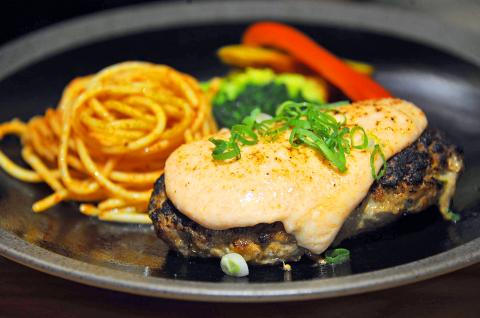
Photo: Han Cheung, Taipei Times
The burgers are all handmade and grilled on an iron skillet, and contain a mixture of Australian beef and Taiwanese pork (sorry, hamburger purists). Pork-only options are also available. All meals come with a small glass of vegetable fruit juice, miso soup and rice. Customers can add NT$149 or NT$199 for a set meal, which includes an appetizer and a drink.
We order the winter special burger served in clam chowder (NT$320) and the mentaiko (salted cod roe) burger (NT$280), along with an NT$199 set meal with a burger croquette appetizer.
The tiny shot of juice, containing tomato, pineapple, orange, celery and carrot, was refreshing and not too sweet. The carrot and tomato flavors stood out the most. It was served to us pretty much right after ordering, which provided relief to my hungry stomach as the food took about 20 minutes.
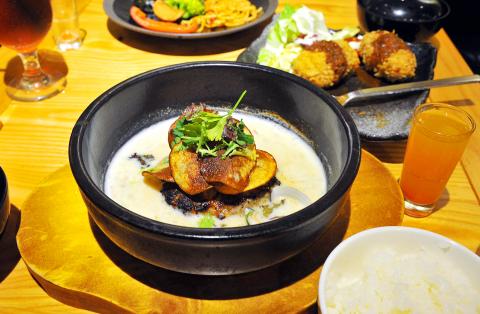
Photo: Han Cheung, Taipei Times
The croquette — which is basically a fried ball-shaped burger stuffed with cheese — was perfectly crispy on the outside, and the ground beef and pork gave us a taste of what is to come — soft and juicy, drawing most of its flavors from the meat, onions, scallions and a dash of pepper. The addition of pork provides a slight sweetness and tenderness. The overall taste is subtle, which is why the restaurant can combine it with so many different ingredients.
In hindsight, it was probably a better idea to go with the baked mushrooms or salad instead — having that much meat, and the same type of meat, in every dish is simply too heavy for the stomach to handle.
The cod roe burger came with roasted pumpkin and other vegetables and a small side of spaghetti. The cod roe mayonnaise sauce carried a sharp and tangy flavor, which contrasts well with the burger. Each bite is best accompanied with the rice, which tempers the flavor while providing new texture. Flown in from Hokkaido, the quality of the rice is immediately noticeable in both chewiness and aroma. The spaghetti with light marinara sauce is rather bland, and there doesn’t seem a need to have two types of starch when there’s already rice.
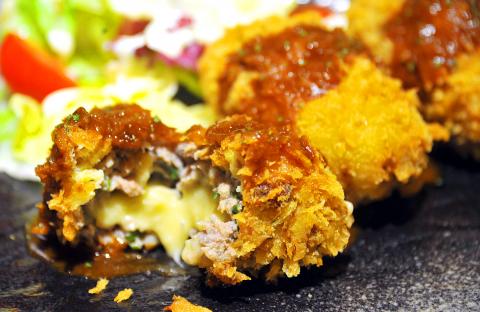
Photo: Han Cheung, Taipei Times
The clam chowder burger, on the other hand, can be eaten both on its own and with rice. There are multiple layers of texture and flavor. The soup is made in a slightly-sweet, not-too-salty Japanese style that is not as thick as the American varieties — instead, it’s packed with grated onions and bacon, making it hearty but not heavy. An extra dimension is added as the soup slightly burns on the iron pot. It comes with about four or five clams which are succulent but a bit small. The burger goes in the middle of the pot, topped with citrusy lettuce and unsalted baked potato chips.
It’s a dish that’s fun to eat — the chips can be devoured dry or dipped in the soup for a fuller potato texture, and the patty, which is already juicy on its own, takes on a new sensation as it soaks in the chowder. Without the tangy mayonnaise of the previous dish, the pepper in the burger is more pronounced. Since the soup isn’t too thick, it goes well with the rice, providing flavor without taking away from the rice’s chewiness.
Here’s when the heaviness of eating all that meat sinks in — remember, order salad next time.
With hambaagu already being a Japanese take on an American dish, Yamamoto has taken it another step away from its origins with its innovations. You’ll go in seeing something familiar but you’ll experience a novel type of cuisine.

Last week, Viola Zhou published a marvelous deep dive into the culture clash between Taiwanese boss mentality and American labor practices at the Taiwan Semiconductor (TSMC) plant in Arizona in Rest of World. “The American engineers complained of rigid, counterproductive hierarchies at the company,” while the Taiwanese said American workers aren’t dedicated. The article is a delight, but what it is depicting is the clash between a work culture that offers employee autonomy and at least nods at work-life balance, and one that runs on hierarchical discipline enforced by chickenshit. And it runs on chickenshit because chickenshit is a cultural

By far the most jarring of the new appointments for the incoming administration is that of Tseng Wen-tsan (鄭文燦) to head the Straits Exchange Foundation (SEF). That is a huge demotion for one of the most powerful figures in the Democratic Progressive Party (DPP). Tseng has one of the most impressive resumes in the party. He was very active during the Wild Lily Movement and his generation is now the one taking power. He has served in many of the requisite government, party and elected positions to build out a solid political profile. Elected as mayor of Taoyuan as part of the
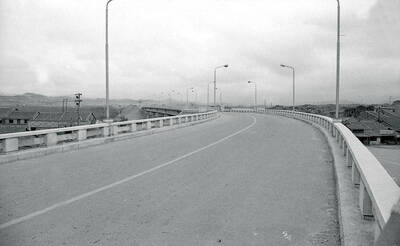
April 29 to May 5 One month before the Taipei-Keelung New Road (北基新路) was set to open, the news that US general Douglas MacArthur had died, reached Taiwan. The military leader saw Taiwan as an “unsinkable aircraft carrier” that was of huge strategic value to the US. He’d been a proponent of keeping it out of Chinese Communist Party (CCP) hands. Coupled with the fact that the US had funded more than 50 percent of the road’s construction costs, the authorities at the last minute renamed it the MacArthur Thruway (麥帥公路) for his “great contributions to the free world and deep
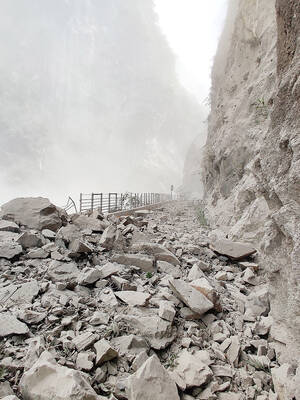
Moritz Mieg, 22, lay face down in the rubble, the ground shaking violently beneath him. Boulders crashed down around him, some stones hitting his back. “I just hoped that it would be one big hit and over, because I did not want to be hit nearly to death and then have to slowly die,” the student from Germany tells Taipei Times. MORNING WALK Early on April 3, Mieg set out on a scenic hike through Taroko Gorge in Hualien County (花蓮). It was a fine day for it. Little did he know that the complex intersection of tectonic plates Taiwan sits